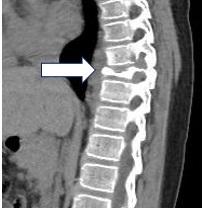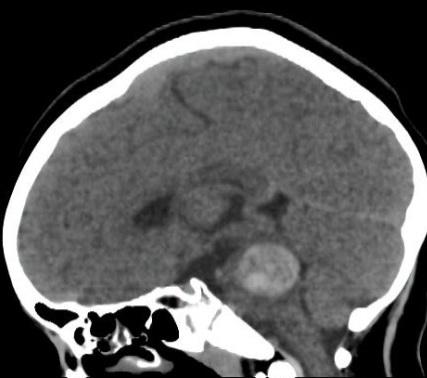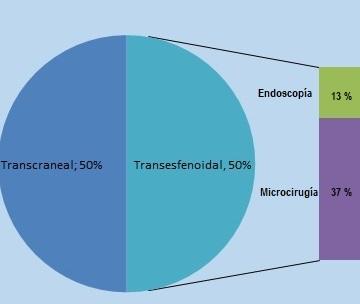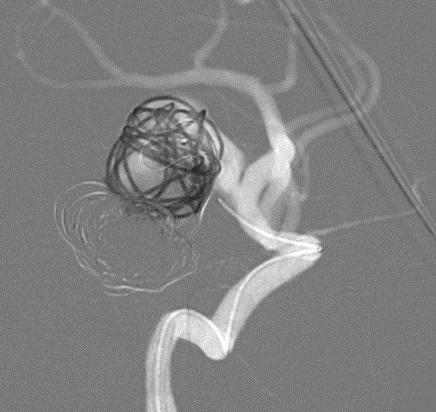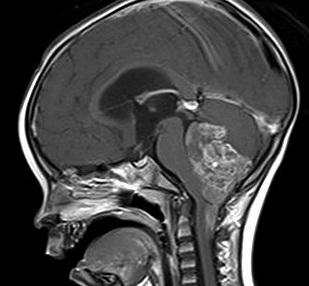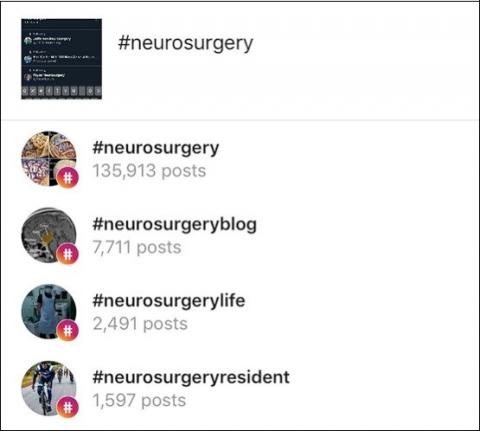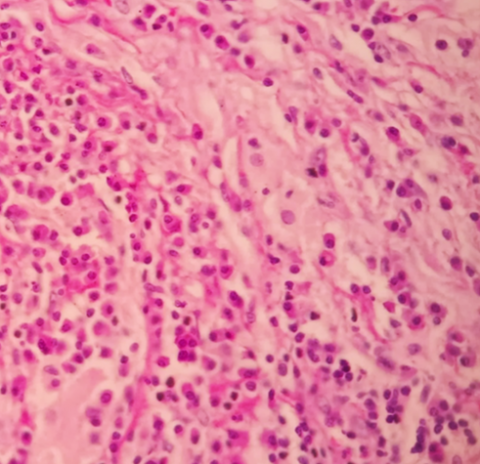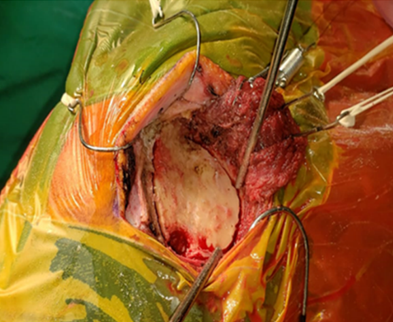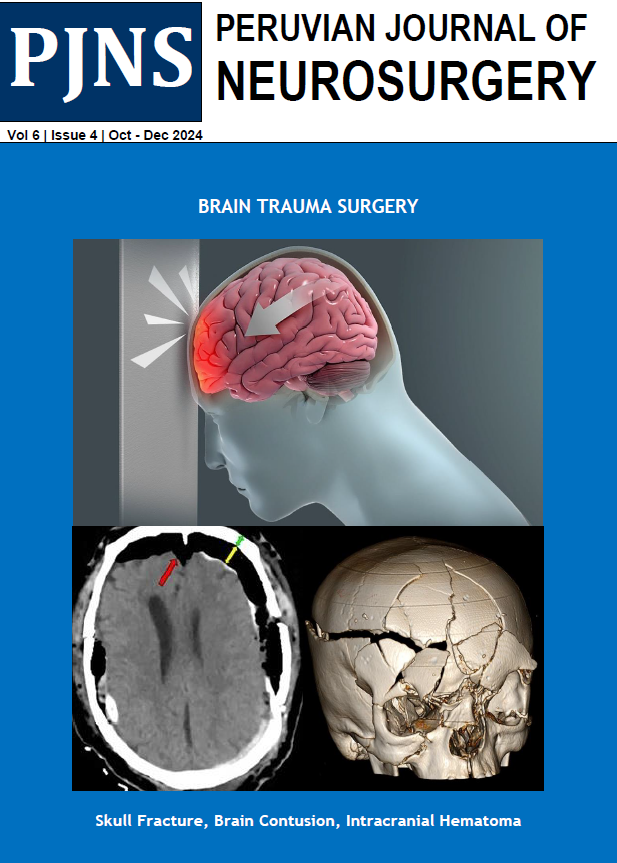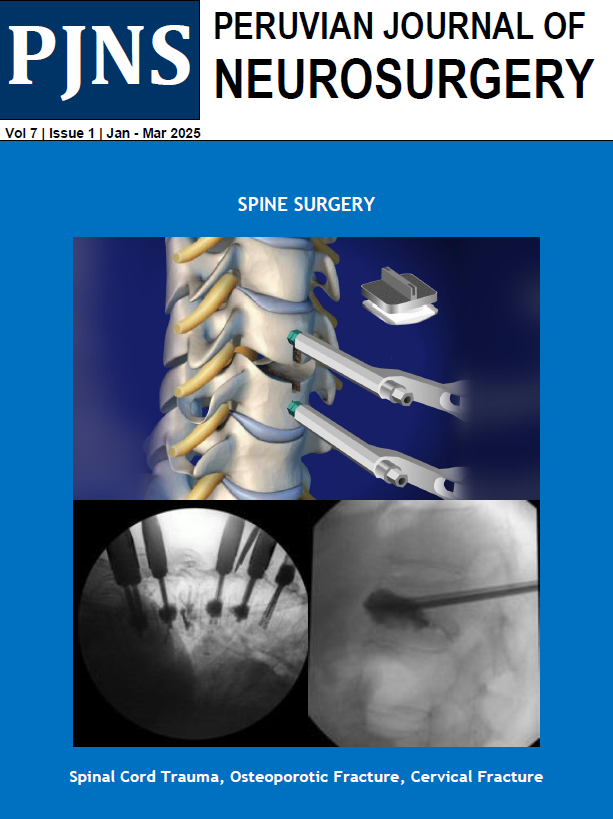Usted está aquí
Peruvian Journal of Neurosurgery
Hydrocephalus in pediatric population. Experience in the Neurosurgery Department of the Baca Ortiz Pediatric Hospital, Quito-Ecuador, 2016-2019
ABSTRACT
|
Introduction: Hydrocephalus is one of the most common pathologies in the daily care of a Pediatric Neurosurgery Service, so it is important to document the context of its presentation to improve therapeutic behavior. The objective of the present study was to describe the demographic variables, as well as the type, treatment, morbidity, and mortality of patients with hydrocephalus.
Methods: Cross-sectional, retrospective, and descriptive study of children with hydrocephalus who underwent surgery in the Neurosurgery Service of the Baca Ortiz Pediatric Hospital, from January 2016 to December 2018, using the records of the clinical records from the Department of Statistics and archives of the Neurosurgery Service of our Institution.
Results: From January 2016 to December 2018, 287 patients with a diagnosis of hydrocephalus underwent surgery, presenting 63.7% as a congenital cause and 36.2% acquired; with a predominance of males (57.2%). The most common sign for which patients attended the consultation was macrocephaly (52%). Infectious dysfunctions were 10.1% vs. mechanical dysfunctions 4%. Mortality was not related to hydrocephalus, 1% of deaths were associated with systemic infection, and 0.6% with a respiratory infection.
Conclusions: Hydrocephalus in pediatric patients constitutes a frequent pathology that can be accompanied by various comorbidities, hence the importance of its timely diagnosis and adequate treatment.
Keywords: Hydrocephalus, Child, Neurosurgical Procedures, Hospitals, Pediatric. (Source: MeSH NLM)
|
Vertebral hydatidosis: case report
ABSTRACT
Langerhans cells histiocytosis in the dorsal spine in a pediatric patient
ABSTRACT
Successful management of ruptured cavernous malformation of the pons
ABSTRACT
Experience in the surgical treatment of pituitary adenomas at the Guillermo Almenara Hospital in 2019-2020
ABSTRACT
Introduction: Pituitary adenomas constitute 25% of the primary benign neoplasms of the brain and can be functional or non-functional, or depending on their size they can be microadenomas, macroadenomas, and giant adenomas. They are mainly treated by surgery using a transcranial or transsphenoidal approach.Objective: To know the experience in the surgical treatment of pituitary adenomas in the Guillermo Almenara National Hospital from January 2019 to May 2020.Methods: Descriptive, retrospective, cross-sectional epidemiological study. 84 cases of patients operated on for pituitary adenoma were found. The data was collected from the medical history and images in the hospital's PACS system. Chi-square was applied as a statistical test.Results: Of the total of patients, 50% were operated by transcranial surgery and 50% by transsphenoidal surgery. Hypertension, Cushing's disease, and acromegaly were statistically significant in favor of transsphenoidal resection. 69.05% were macroadenomas in transsphenoidal resection (TSR) and 61.90% in transcranial resection (TCR). In the TSR there were 4.76% of intraoperative complications, and in the TCR it was 19.05%. The total resection grade was greater than 50% in both groups.Conclusions: Pituitary adenomas are a frequent pathology and can be treated by transcranial or transsphenoidal approach, with good resection rates. Prospective studies are required to determine the causal relationship between the variables. Keywords: Pituitary Neoplasms, Acromegaly, Craniotomy, Endoscopy (Source: MeSH NLM)
|
Malfunction of the valvular shunting system in children. Experience in the Neurosurgery Department of the Baca Ortiz Pediatric Hospital, Quito-Ecuador, 2016-2019
ABSTRACT
Introduction: The prevalence of valve dysfunction (VD) in pediatric centers is high. A descriptive observational study was carried out, the objective of which was to find factors: epidemiological characteristics of hydrocephalus and other derivatives of the ventricle-peritoneal shunt system (VPSS) associated with VD.Methods: All the diagnoses of VD for 3 years in the Neurosurgery Service of the Baca Ortiz Pediatric Hospital (BOPH) were collected, clinical-epidemiological variables associated with hydrocephalus and shunting were selected. VD was defined as the revision of the referral in patients using VPSS for malfunction. Multi-categorical variables and the prevalence of qualitative variables were analyzed using statistical analysis.Results: A total of 376 children were initially subjected to VPSS placement between August 2016 and August 2019. 71 patients with VD were treated, of whom 60 were included in the study; of these 48 were treated at BOPH. Infectious dysfunction was found to be more frequent in children < 1-year, mechanical dysfunction in children > 5 years (64% and 38% respectively p <0.002). Also, the permanence of the VPSS <1 year was more frequent in infectious dysfunctions and the permanence of 1 to 5 years was more related to mechanical dysfunction (72 and 46% respectively p 0.03). The distal catheter dysfunction was more important in mechanical and mixed etiology (65.41 respectively p <0.001) and that of the ventricular catheter in infectious etiology (81% p <0.001). No independent association of VD was found with the etiology of hydrocephalus, the ventricular catheter site or with the Lansky scale.Conclusions: Valvular dysfunction in pediatric hydrocephalic patients is an important complication that warrants further investigation.Keywords: Hydrocephalus, Catheters, Neurosurgical Procedures, Hospitals, Pediatric. (Source: MeSH NLM) |
Embolization of ruptured giant aneurysm of the medium cerebral artery followed by surgical evacuation of intracerebral hematoma
ABSTRACT
Successful endovascular management of a ruptured cerebral aneurysm in an infant patient
ABSTRACT
Endovascular treatment of a large, embolized, unruptured cerebral aneurysm that presented rechanneling
ABSTRACT
Introduction: Endovascular treatment of ruptured and non-ruptured brain aneurysms is an appropriate option in most patients. In narrow neck aneurysms, treatment with coils is sufficient, but in those with wide necks, the use of stent-assisted coils or flow diverters is necessary. Endovascular treatment of intracranial aneurysms is effective and provides complete occlusion in up to 85% of cases, however, there are cases of incomplete obliteration or recanalization that require treatment.Clinical Case: A 79-year-old woman with a history of high blood pressure and embolization with coils of an unruptured cerebral aneurysm of the left posterior communicating artery, 5 years ago, Raymond Roy I in the immediate postoperative period. She has been presenting with right hemiparesis and III left cranial nerve palsy for 1 year. An angiotomography (angioCT) showed recanalization of the aneurysm, so it was decided to perform an embolization with coils and stents, achieving complete occlusion of the aneurysm (Raymond Roy I). In the following weeks, the patient regained strength in the right hemibody and recovered function of the III left cranial nerve.Conclusion: Recanalization of aneurysms undergoing endovascular treatment is infrequent, less than 10%, and is associated with complex aneurysms. In these cases, the use of advanced or combined endovascular techniques is recommended to achieve total closure of the aneurysm and decrease the associated morbidity and mortality rate.Keywords: Intracranial Aneurysm, Endovascular Procedures, Stent, Embolization Therapeutic. (Source: MeSH NLM) |
Experience in diagnostic and treatment of central nervous system tumors in children less than 2 years at the Baca Ortiz Pediatric Hospital, Quito-Ecuador, 2016-2019
ABSTRACT
|
Introduction: Tumors of the central nervous system (CNS) in children between 0 and 2 years of age are infrequent, so their diagnosis and treatment constitute an important challenge for every pediatric neurosurgical center, to which is added the comorbidities typical of this age that condition the responsibility of improving therapeutics to obtain better survival. The objective of this study was to describe the diagnostic and therapeutic experience of a neurosurgical Department of national reference, in relation to neoplasms of the central nervous system in children under two years of age, as well as to establish comorbidity and prognosis.
Methods: Cross-sectional, retrospective and descriptive study that includes all patients under 2 years of age who were diagnosed with a neoplastic lesion of the central nervous system, attended from January 01, 2016 to July 01, 2019 at the Baca Ortiz Pediatric Hospital from the city of Quito in Ecuador.
Results: CNS tumors in children between 0 and 2 years old corresponded to 5.09%, with irritability being the most frequent reason for consultation with 62.5%. Also, 75% of the neoplasms were located at supratentorial level with a 1: 1 intra / extra-axial ratio. Neuroblastoma and choroid plexus tumors were the most frequent histopathological diagnoses. Mortality had a percentage of 50%.
Conclusions: CNS tumors in children between 0 and 2 years are not frequent, the location is predominantly supratentorial and the prognosis for life depends on the histopathological type. Radiation therapy is an option, although surgery for resection is the basis of treatment.
Keywords: Central Nervous System Neoplasms, Comorbidity, Prognosis. (Source: MeSH NLM)
|
Use of social media networks in Neurosurgery
ABSTRACT
|
Neurosurgery as a medical discipline has always been on the cutting edge of technology and the latest advancements. It’s not a surprise why modern neurosurgeons actively utilize various social media platforms, in order to share the latest news or showcase interesting cases they face daily. From Twitter to LinkedIn neurosurgical professionals of the world share the knowledge and connect with each other in order to advance their skills to the next level. A thought-provoking content is constantly shared and spark many interesting conversations and contribute to the modern data of neurosurgical field. Keywords: Social Media, Neurosurgery, Graduate Medical Education (source: MeSH NLM)
|
Isolated intracranial Rosai-Dorfman disease: case report
ABSTRACT
Enterogenous cyst of the posterior fossa: a case report
ABSTRACT
Introduction: The intracranial enterogenous cyst is a benign cystic tumor lesion of very rare frequency worldwide. These cysts can occur at any level of neuroaxis and their malignant transformation is rare. The case of a 32-year-old woman with a cystic lesion in the posterior fossa at the level of the occipitocervical junction is presented.
Minimally invasive surgery using Mini-pterional Interfascial Approach for the Clipping of a Ruptured Aneurysm of the right Carotid Bifurcation at the Dos de Mayo National Hospital, Lima-Peru
ABSTRACT
|
Introduction: Carotid bifurcation aneurysms represent 2 to 9% of intracranial aneurysms1. They can be treated by endovascular or microsurgical techniques3, the latter being the most complex1-4 and used with low frequency in this type of aneurysm7.
Clinical case: A 57-year-old woman with a ruptured aneurysm of the right carotid bifurcation, incidentally, another small unruptured aneurysm of the left posterior communicating was found. She underwent a mini-pterional interfascial approach and aneurysm clipping with satisfactory results and a favorable evolution.
Conclusion: Aneurysms of the carotid bifurcation are not frequent; this is a non-common case due to the age of 57 years. The technique performed allowed the identification of the aneurysm, as in the classical pterional approach, but trying to minimize morbidity. The patient did not present post-surgical complications despite the risk factors presented, such as unbroken contralateral aneurysm, edema due to subarachnoid hemorrhage and arterial hypertension.
Keywords: Aneurysm, Ruptured, Subarachnoid Hemorrhage, Hypertension. (Source: MeSH NLM)
|
Minipterional interfascial approach for microquirurgical treatment of ruptured and unruptured anterior circulation aneurysms. Initial experience in the Dos de Mayo National Hospital in Lima - Peru
ABSTRACT
|
Objective: To provide information on the experience in the management of ruptured and non-ruptured aneurysms of the anterior circulation through the minipterional interfascial approach, to describe the technique, clinical, surgical results, complications and advantages.
Methods: A retrospective observational study was conducted, from January to December 2018. Of 59 patients with ruptured and non-ruptured aneurysms, 33 were using a minipterional craniotomy. Clinical variables, location, complications and surgical results were analyzed.
Results: In total, there were 33 patients operated by a minipterional craniotomy, 35 aneurysms were clipped: 14 MCA (40%), 13 PComA (37%), 6 AComA (17%), 1 bifurcation of ICA (2%), 1 Choroid artery (2%). Of the total, 11 were men (33%), 22 women (66%). The Hunt and Hess of admission: I in 16 cases (48%), II in 11 cases (33%) and III in 6 cases (18%). There were 3 intraoperative ruptures and 8 radiological clinical vasospasms. Rankin's scale at discharge was: Rankin 0 in 2 patients (6%), Ranking 1 in 11 patients (33%), Rankin 2 in 10 patients (30%), Rankin 3 in 2 patients (6%), Rankin 4 in 1 patient (3%), Rankin 5 in 1 patient (3%) and Rankin 6 in 1 patient (3%).
Conclusions: The Minipterional craniotomy is reliable, less invasive, it maintains the advantages of the pterional approach but avoids greater exposure of the parenchyma and tissue manipulation. Aneurysms of the anterior circulation, ruptured and unruptured, can be treated safely and effectively with limited bone extraction, good cosmetic results and good temporomandibular function.
Keywords: Intracraneal Aneurysm, Craniotomy, Surgical Instruments. (source: MeSH NLM
|



